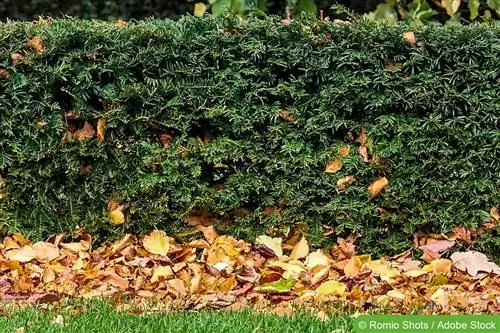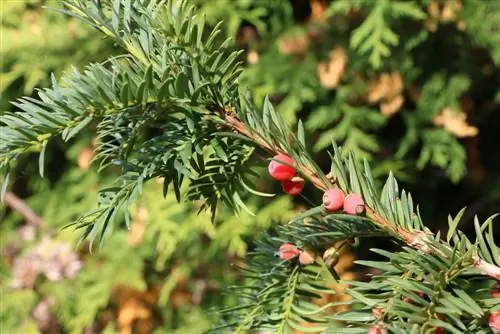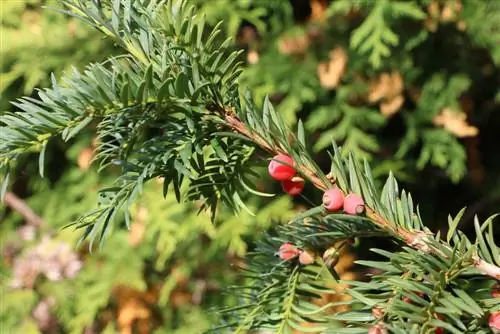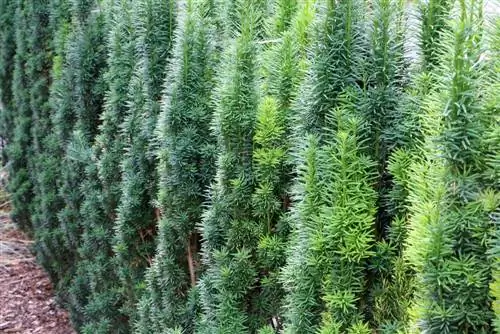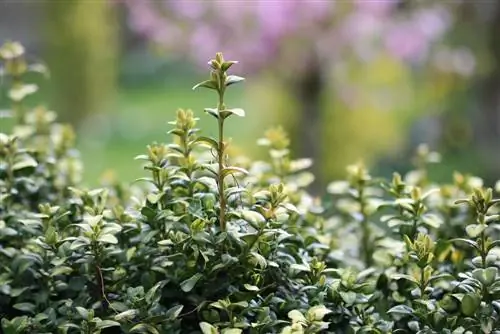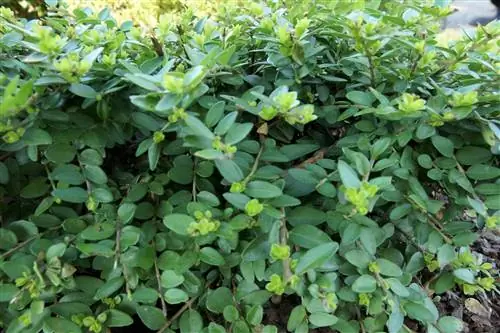- Author admin [email protected].
- Public 2023-12-17 03:39.
- Last modified 2025-01-24 12:45.
A hedge yew can become an attractive and opaque addition to the garden if it receives the right care. From choosing the best location to how to proceed with the waste, there are a number of factors and requirements to consider. If emphasis is placed on this during cultivation, the evergreen plant proves to be comparatively undemanding and easy to care for. This makes it very suitable for beginners and anyone who wants to relax in the countryside.
Location
When choosing a location, hobby gardeners have almost complete freedom to decide. Sun or shade, the hedge yew thrives in both and everything in between. However, it should be noted that the yew tree grows much slower in the shade than in a bright place. So if you want a quick privacy screen, a shady location for the hedge yew is not a good idea. The plants do not need any protection from wind or weather; they are quite robust and resilient. There is also no need for a large distance to other plants or paving slabs and walls. The roots of the yew trees are not destructive and therefore do not pose a danger to stones, pipes or cables.
Substrate
Choosing the substrate for the hedge yew is just as easy as finding a suitable location, because it is actually happy with almost anything. The soil should only be well-drained, because waterlogging or compacted soil is not good for the yew trees. A coarse and loose substrate, which can also be stony, would be ideal. Equal parts fresh garden soil, sand and peat are an ideal combination. If you don't want to use peat, you can replace it with coconut fiber.
Tip:
If the groundwater level is high, a drainage layer should be placed under the substrate.
Plants
The best time to plant hedge yew is in spring, after the last frost. The date should therefore be between March and May.
The following instructions will help create the basis for a dense and he althy hedge:
- The desired course of the hedge is sketched using a stretched thread, sticks or chalk.
- To promote growth, a trench should be dug instead of individual planting holes. This is at least twice as wide and deep as the root ball. If you want to promote rapid and strong growth, make the planting trench larger.
- If necessary, a drainage layer is first applied to the ground. This can consist of larger stones, pottery shards, grit or gravel.
- The substrate mixture described is filled into the excavated space so high that the root axis is flush with the surface of the earth when the plant is placed. Adding horn shavings or blue grain promotes a strong start.
- The young yew trees are planted about 40 cm apart. 60 cm is also possible and is the better choice in the long term, as the individual plants do not compete with each other.
- The trench is filled with substrate, which is then tapped into place.
- You should water abundantly immediately after planting.
Pouring
During the first year of growth, the hedge yew needs a constantly moist but not wet substrate. Watering adapted to needs is therefore mandatory. After this initial phase, additional watering can be greatly reduced as the plants take care of themselves after they have grown. Only if the weather continues to be dry should you use a watering can or hose. It doesn't matter whether the dry phase falls in summer or winter. In winter, however, it should be noted that watering takes place on mild, frost-free days.
Tip:
The hedge yew not only tolerates lime, but actually needs it. Watering with hard water is therefore beneficial.
Fertilize
Just like when planting, blue grain and horn shavings are also appropriate for fertilization. Alternatively, a conifer or fir fertilizer can be used. The additional nutrient supply takes place for the first time in the spring of the second year, ideally shortly after new shoots begin. One gift per year is enough.
Intersection
The hedge yew does not need any trimmings and grows densely even without it. However, she tolerates him very well. Cutting can therefore be avoided completely or can be done right down to old, woody parts of the plant. This is possible all year round on frost-free days. However, an appointment before budding in spring is ideal. In the case of old hedge yews that are bare or dry at the bottom, these parts should be radically trimmed. This has a rejuvenating effect.
Tip:
Due to the toxicity of the yew tree, skin contact with fresh cuts should be avoided.
- If the hedge yew has become bare at the bottom, it can even be shortened extremely because it will sprout again from the old wood.
- However, it is best to shorten all outstanding shoots once a year.
- To avoid baldness in the lower area of the hedge, it should be cut trapezoidally, i.e. slightly narrower at the top than at the bottom, so that enough light also falls into the lower area of the hedge.
In principle, the hedge yew can be pruned all year round, but the best time for this is early spring, before new growth begins. If the cutting takes place in the summer months, the hedge should be carefully examined for bird nests beforehand, as many bird species like to use the hedge yew for their breeding grounds.
Wintering
Winter protection is not necessary for the hedge yew. However, it must be noted that the yew can dry out or at least be damaged by drought even in the cold season. The soil should therefore be moistened during frost-free periods. However, waterlogging must be avoided.
Typical care errors, diseases and pests
Only a few diseases and pests can harm the hedge yew. Dangerous are:
- Fungal infections
- Scale insects
- Bigmouth Weevil
Fungal infections, which are manifested by a musty smell and discoloration of the needles, occur almost exclusively when the culture is too wet. The best prevention is achieved through drainage and appropriate watering. Once infected by fungi, the yew tree can still be treated by removing the affected parts and using fungicides.
If there are pests or even just traces of feeding on the hedge yew, the plants should be rinsed at dawn or dusk using medium to strong water pressure. If this measure alone does not bring any improvement, covering or replacing the soil and using appropriate insecticides can stop the infestation.
The most common care mistake relates to the water balance of the hedge yew. Moist substrate is optimal, but wet and dry conditions are not.
Frequently asked questions
Is the hedge yew poisonous?
Leaves, wood and fruits of the yew tree contain toxins that, even in very small quantities, can lead to life-threatening conditions. Both in pets and in people. It is therefore out of place in a garden where children or animals play, plants are torn or hands and paws sometimes end up in mouths and mouths. In addition, any contact with the skin must be avoided when cutting the hedge yew.
Is the yew tree suitable for shaped hedges?
Due to its dense growth and good pruning tolerance, the hedge yew can be shaped into unusual shapes. However, due to the slow growth, some patience is necessary.
What you should know about hedge yew in brief
The hedge yew (Taxus baccata) is one of the popular hedge trees because it is evergreen and therefore offers good visibility and wind protection even in winter. It can be used for a very tall hedge because it grows up to four meters high, but can also be easily maintained at any desired height with regular trimming. The hedge yew grows very slowly and forms a lot of branches with numerous soft needles in a deep green color, which make such a hedge very dense. But it is also suitable for smaller hedges that border individual areas in the garden. It can be planted near paths without any concerns because its roots are very fine and therefore - unlike other plants that can lift slabs and even asph alt - do not cause any damage. From July onwards, red berries form on a hedge yew tree, which the birds use as food.
Location and care
- The hedge yew grows best in a sunny or at least bright location.
- It can also be used for a hedge that is in the shade most of the day, but it grows slowly there.
- It doesn't place any special demands on the soil, it just needs to be well-drained so that it doesn't become waterlogged.
- So that the hedge becomes dense and later offers good privacy, the plants are placed at a distance of around 30 to 40 cm.
- In general, a yew hedge can supply itself with enough water. It should only be watered regularly in the initial period after planting.
- However, as an evergreen plant, it also needs water in winter, so it should also be watered on frost-free days during long dry periods.
- The hedge yew does not need winter protection because it is very hardy as a native plant.
Cutting
The hedge yew does not necessarily need to be cut because it grows quite slowly at 20 to 40 cm per year. However, it is very compatible with cutting and can therefore be easily kept at the desired height and width.
Propagate
- The hedge yew can be easily propagated by cuttings.
- To do this, shoots are cut off at the end of summer and placed in pots with potting soil.
- The soil is then kept evenly moist so that the cuttings can form their own roots.
- After the newly grown plants have reached a sufficient height, they can be planted out in the garden as hedge plants or as individual trees.
Caution: Toxicity
The hedge yew is very suitable as a hedge tree, but has the disadvantage that it is highly poisonous. Horses and pets are particularly at risk, as are small children who could eat the red berries. Because of its high toxicity, clippings from a yew hedge should never be fed to animals.

